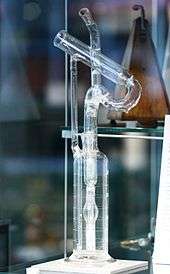Perfusion

In physiology, perfusion is the process of a body delivering blood to a capillary bed in its biological tissue. The word is derived from the French verb "perfuser" meaning to "pour over or through."[1]
Tests verifying that adequate perfusion exists are a part of a patient's assessment process that are performed by medical or emergency personnel. The most common methods include evaluating a body's skin color, temperature, condition and capillary refill.
Discovery
In 1920, August Krogh was awarded the Nobel Prize in Physiology or Medicine for his discovering the mechanism of regulation of capillaries in skeletal muscle.[2][3] Krogh was the first to describe the adaptation of blood perfusion in muscle and other organs according to demands through the opening and closing of arterioles and capillaries.
Overperfusion and underperfusion
The terms "overperfusion" and "underperfusion" are measured relative to the average level of perfusion that exists across all the tissues in an individual body, and should not be confused with wrong hypoperfusion and "hyperperfusion", which measure the perfusion level relative to a tissue's current need to meet its metabolic needs.
Heart tissues, for example, are usually classified as being overperfused because they normally are receiving more blood than the rest of tissues in the organism. In the case of skin cells, extra blood flow in them is used for thermoregulation of a body. In addition to delivering oxygen, blood flow helps to dissipate heat in a physical body by redirecting warm blood closer to its surface where it can help to cool a body through sweating and thermal dissipation.
Measurement
Microspheres
Microspheres that are labeled with radioactive isotopes have been widely used since the 1960s. Radioactively labeled particles are injected into the test subject and a radiation detector measures radioactivity in tissues of interest.[4] Application of this process is used to develop radionuclide angiography, a method of diagnosing heart problems.
In the 1990s, methods for using fluorescent microspheres became a common substitute for radioactive particles.[5]
Nuclear medicine
Perfusion of various tissues can be readily measured in vivo with nuclear medicine methods which are mainly positron emission tomography (PET) and single photon emission computed tomography (SPECT). Various radiopharmaceuticals targeted at specific organs are also available, some of the most common are
- 99mTc labelled HMPAO and ECD for brain perfusion (rCBF) studied with SPECT
- 99mTc labelled Tetrofosmin and Sestamibi for myocardial perfusion imaging with SPECT
- 133Xe-gas for absolute quantification of brain perfusion (rCBF) with SPECT
- 15O-labeled water for brain perfusion (rCBF) with PET (absolute quantification is possible when measuring arterial radioactivity concentration)
- 82Rb-chloride for measuring myocardial perfusion with PET (absolute quantification is possible)
MRI
Two main categories of magnetic resonance imaging (MRI) techniques can be used to measure tissue perfusion in vivo.
- The first is based on the use of an injected contrast agent that changes the magnetic susceptibility of blood and thereby the MR signal which is repeatedly measured during bolus passage.[6]
- The other category is based on arterial spin labelling (ASL), where arterial blood is magnetically tagged before it enters into the tissue being examined and the amount of labelling that is measured and compared to a control recording obtained without spin labelling.[7]
CT
Brain perfusion (more correctly transit times) can be estimated with contrast-enhanced computed tomography.[8]
Thermal diffusion
Perfusion can be determined by measuring the total thermal diffusion and then separating it into thermal conductivity and perfusion components.[9] rCBF is usually measured continuously in time. It is necessary to stop the measurement periodically to cool down and reassess the thermal conductivity.
See also
References
- ↑ "Perfusion > What is Perfusion?". Cardiovascular Perfusion Forum.
- ↑ Larsen, E. H. (2007). "August Krogh (1874-1949): 1920 Nobel Prize". Ugeskrift for laeger 169 (35): 2878. PMID 17877986.
- ↑ Sulek, K. (1967). "Nobel prize for August Krogh in 1920 for his discovery of regulative mechanism in the capillaries". Wiadomosci lekarskie (Warsaw, Poland : 1960) 20 (19): 1829. PMID 4870667.
- ↑ Studies of the Circulation with Radioactive Microspheres., Wagner et al,Invest. Radiol., 1969. 4(6): p. 374-386.
- ↑ "Fluorescent Microspheres" (PDF). Fluorescent Microsphere Resource Center.
- ↑ Huettel, S. A.; Song, A. W.; McCarthy, G. (2009), Functional Magnetic Resonance Imaging (2 ed.), Massachusetts: Sinauer, ISBN 978-0-87893-286-3
- ↑ Detre, John A.; Rao, Hengyi; Wang, Danny J. J.; Chen, Yu Fen; Wang, Ze (2012-05-01). "Applications of arterial spin labeled MRI in the brain". Journal of magnetic resonance imaging: JMRI 35 (5): 1026–1037. doi:10.1002/jmri.23581. ISSN 1522-2586. PMC 3326188. PMID 22246782.
- ↑ L. Axel. Cerebral blood flow determination by rapid-sequence computed-tomography: theoretical analysis. Radiology 137: 679-686, December 1980
- ↑ Vajkoczy P, Roth H, Horn P, et al. (August 2000). "Continuous monitoring of regional cerebral blood flow: experimental and clinical validation of a novel thermal diffusion microprobe". Journal of Neurosurgery 93 (2): 265–74. doi:10.3171/jns.2000.93.2.0265. PMID 10930012.
External links
- Perfusion Protocol
- University of Iowa Perfusion Technology Program
- SUNY Upstate Medical University Perfusion Program
- Cardiac Surgery Portal
- The New Orleans Conference: Practices in Cardiac Surgery and Extracorporeal Technologies
| ||||||||||||||||||||||||||||||||||||||||||
| |||||||||||||||||||||||||||||||||||||||||||||||||||||||
